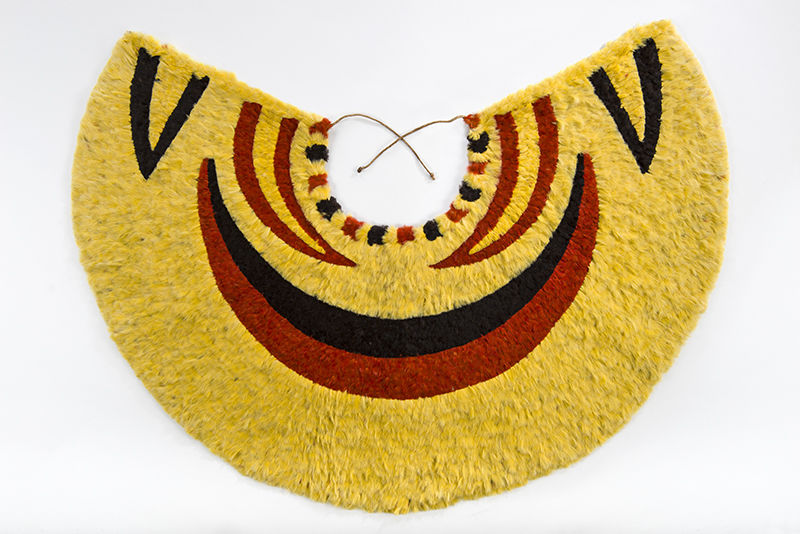Skip the Robert Mapplethorpe.
Instead, go to LACMA before Aug. 7 and check out a truly transcendent exhibit called “Royal Hawaiian Featherwork: Na Hulu Ali‘i.”
“For centuries on the Hawaiian Islands,” you may not have known, “vividly colored feathers gathered from native birds were valuable cultural resources, ornamenting spectacular garments painstakingly constructed by hand. … [The garments] bore rainbows of feathers to signify the divinity and power of chiefs (ali‘i), who wore them for spiritual protection and to proclaim their identity and status. These unique valuables also found use as objects of diplomacy, helping to secure political alliances and agreements.”
The first documented visit of Westerners to the Hawaiian Islands occurred in December 1778, when Captain James Cook and his crew arrived. When they left, they took with them more than 40 featherwork garments that had been bestowed as diplomatic gifts. Featherwork evolved over the course of the ensuing monarchies and the next 100 years.
A sense of old-world courtesy and class surrounds the garments, which were often bestowed as signs of gratitude and respect. A gorgeous feathered cape was given by King Kamehameha III, for example, to “Mary Perkins, the daughter of Mr. and Mrs. Rufus Perkins of Boston” as a “token” after Mary was born in Honolulu in 1834. Kamehameha IV gave a short cape of deep gold as an expression of sympathy to Lady Franklin, the widow of the British Royal Navy Officer and explorer John Franklin, who sailed from England in 1845 to seek the Northwest Passage and whose ship disappeared.
Fewer than 300 known examples of royal featherwork remain. The splendid, almost mythic garments include ‘ahu ‘ula (long cloaks and short capes), mahiole (helmets) and lei hulu (leis).
The primary colors are a saturated blood-red (most commonly from the ‘i’iwi), a deep, rich yellow, and black (both often from the ‘o-‘o). The exhibit includes color prints by Dutch bird illustrator Johannes Gerardus Keulemans (1842-1912) depicting some of the other creatures whose feathers were used for the royal garments: the jet black and imperial yellow mamo, and the O’ahu ‘akialoa (honeycreeper), with its long slender curved beak and thrillingly deep gold plumage.
The designs feature crescents, long narrow triangles, arrow shapes and black edging.
Christina Hellmich, curator of a featherwork exhibit last year at San Francisco’s de Young Museum, tells of the making of the garments:
“Hulu o na manu, or bird feathers from certain island birds, were highly sought. Kia manu, skilled bird catchers, understood the behaviors and environments of these birds, and they used a variety of techniques to attract and capture them to procure their feathers. …
“Bundles of feathers were tied together and attached to netting made of olona, a member of the nettle family and among the strongest natural fibers in the world. The size, drape and movement of the netting used were determined to accentuate the light on cloaks and capes when worn, highlighting the feathers’ beauty. For helmets, the feathered netting was fastened onto a twined rigid form of ‘ie‘ie aerial roots that allowed the feathers to maintain a specific shape, orientation, and arrangement.”
With an eye toward future generations, Kamehameha I (1736-1819) ordered his kia manu, or bird catchers, to release the birds after taking just a few of their feathers. Nonetheless, many of the species whose feathers were used are now extinct or endangered.
One 19th century kahili (royal staff of feathers) included blue peafowl feathers, dyed goose feathers, green sea turtle shell, whale ivory and yellow and cream ribbon. Kahili were symbols of noble rank, brought out for coronations and funerals. Fanciful and explosively extravagant, some staffs could be held in the hand; others were large and elaborate enough to require a stand.
A cape from 1882 associated with Queen Kapi’olani (1834-1899) — fashioned from brown pheasant feathers, brown and black fowl feathers, velvet, silk and “frog-style” clasps — would even today make a dashing splash, thrown over a pair of creamy young shoulders at the opera.
The British Museum houses five feathered god images. In the book “Royal Hawaiian Featherwork” (University of Hawaii Press, 2015), poet-scholar Noelle Kahanu observes of seeing them: “I was not prepared for their size, their intensity, or their magnitude, in numbers but also in sheer presence. … What I experienced was a profound sense not of my looking at them, but of their looking at me. It was as if they were asking me, ‘Who are you?’ ‘Why are we here?’ ‘What are you going to do about it?’ To be in the presence of sacred objects, created in a time so very different from our own, is to ask ourselves, ‘How have we changed?’”
The follower of Christ, of course, continually in the presence of sacred objects, asks those questions every day.
In 1893, a coup led primarily by U.S.-based businessmen deposed Queen Lili’uokalani, the last of the reigning monarchs. The Republic of Hawai’i was annexed to the United States in 1898. The royal featherwork was removed from the ‘Iolani Palace and relegated to the Bishop Museum.
Thus was colonial rule established.
Thus, the birds fell from the sky, and were silenced.
Heather King is a blogger, speaker and author of several books.

